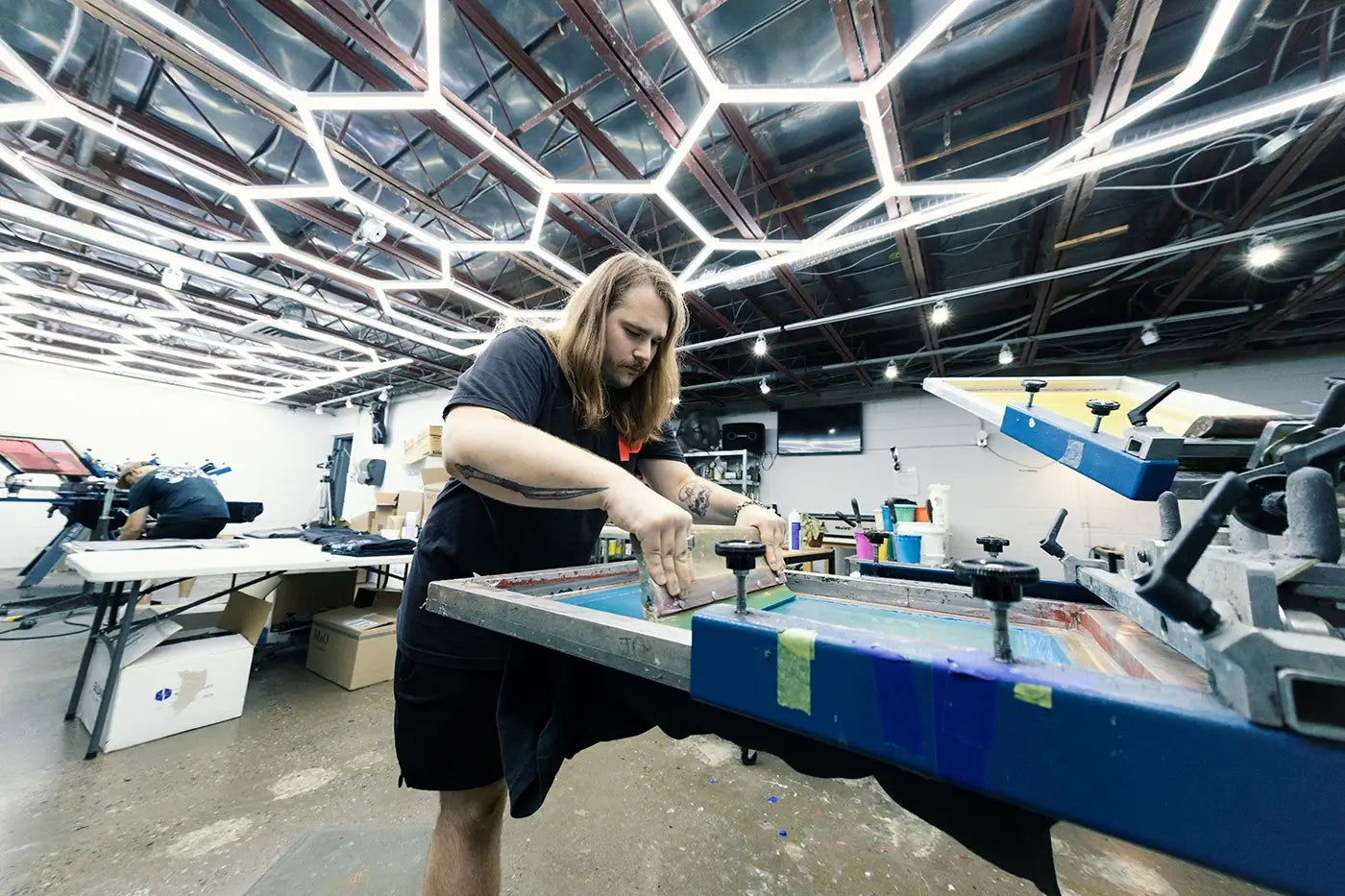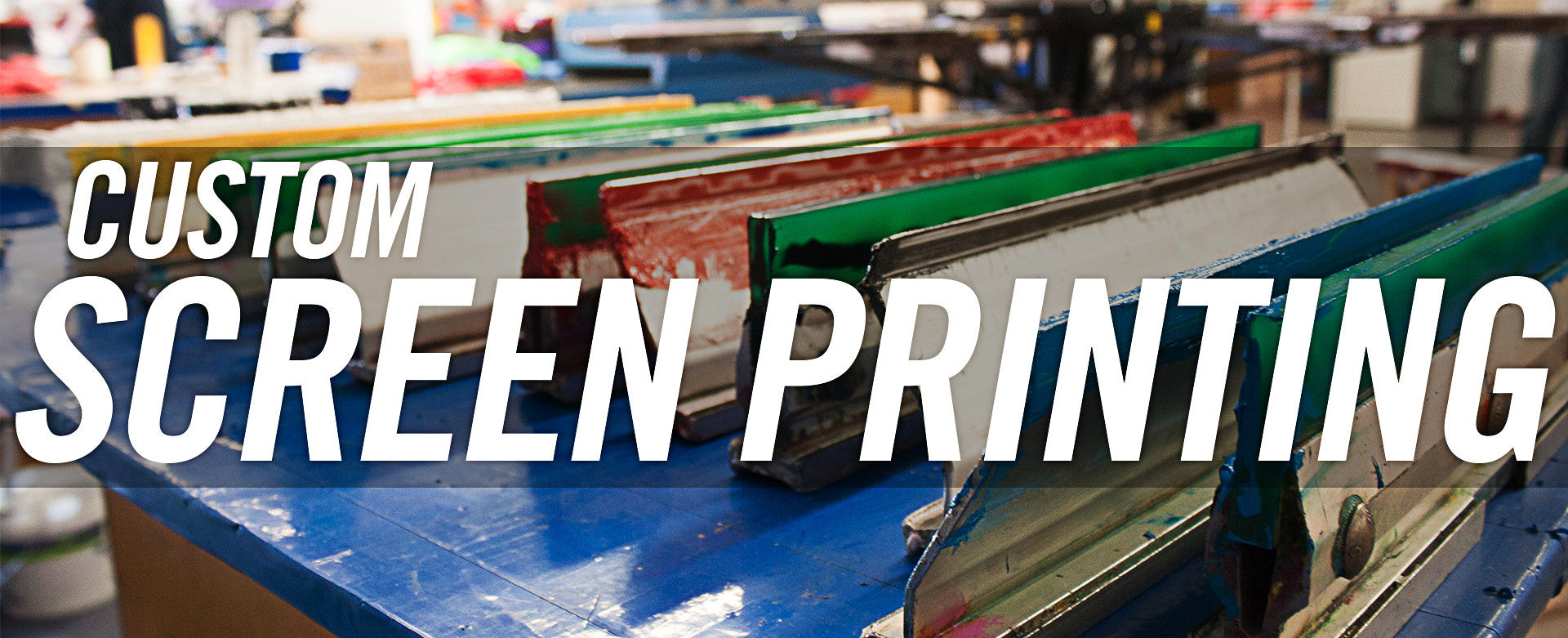Fast Turnaround Custom Screen Printing for Events
Fast Turnaround Custom Screen Printing for Events
Blog Article
Screen Printing Uncovered: Everything You Need to Know Concerning T-Shirt and Garment Printing Methods
Screen printing is a remarkable approach that combines art with strategy, providing unlimited possibilities for creativity. Ready to explore the important aspects that make display publishing an art kind?
The Fundamentals of Screen Printing: Exactly How It Works
When you dive into screen printing, you'll find it's both an art and a science. At its core, screen printing entails producing a stencil, or display, that permits ink to pass via just in particular locations.
Position the screen over the fabric, after that make use of a squeegee to push ink via the screen onto the garment. Each action is essential, and mastering them will certainly boost your display printing skills, transforming basic garments into unique, meaningful items.
Kinds Of Screen Printing Strategies
When you understand the fundamentals of display printing, it's time to check out the numerous strategies that can boost your layouts. One preferred technique is conventional display printing, where ink is pressed via a stenciled display.
If you're aiming for fine details, consider discharge printing. This strategy removes color from the material, leaving a soft, classic look. One more choice is plastisol printing, understood for its durability and vivid shades, making it a favorite for numerous brands. Lastly, experiment with halftone printing to develop slope effects and complex designs. Each technique has its unique charm, so do not wait to try them out to discover what matches your design best!
Vital Devices for Display Printing
To accomplish sensational lead to display printing, having the appropriate equipment is basic. You'll need a strong display printing frame, which holds the mesh that moves your layout onto the garment. Next off, buy high-grade squeegees; these are necessary for using ink equally throughout the display. You'll likewise need an excellent exposure device to create your screens, as well as a washout cubicle for cleaning them after use. A trusted warmth resource, like a conveyor dryer or warm press, is important for treating your prints to guarantee longevity. Don't forget a proper work space, outfitted with tables and storage for your supplies. Finally, protective equipment, such as handwear covers and masks, will certainly maintain you secure from chemicals and inks. With the right devices, you'll be well on your method to generating professional-quality prints.
Picking the Right Inks and Materials
When picking inks and products for display printing, you need to take into consideration the kind of ink that functions ideal for your task. Consider fabric compatibility to assure your styles look great and last lengthy. Discover eco-friendly ink choices to make your printing process extra lasting.
Kinds Of Screen Inks
Choosing the best screen ink is essential for accomplishing dynamic, resilient prints that meet your task's needs. There are a number of kinds of display inks to examine. Specialized inks, such as metallic or glow-in-the-dark, can add unique effects to your designs.

Textile Compatibility Considerations
Understanding fabric compatibility is vital for achieving top notch screen prints, especially given that different materials respond uniquely to various inks. Always check your inks on example fabric to assure they adhere appropriately and keep color stability. Furthermore, keep in mind that material weight and structure can affect the final outcome, so choosing the best ink and product combination is crucial for your task's success.
Eco-Friendly Ink Options
Eco-friendly inks are becoming a popular option for display printers that wish to lessen their ecological influence while maintaining high quality. When picking inks, think about water-based inks, which are much less unsafe and less complicated to tidy up contrasted to traditional solvents. These inks bond well with materials, supplying dynamic outcomes without toxic chemicals. You might likewise discover eco-solvent inks that make use of fewer volatile organic compounds (VOCs), making them a more secure alternative for both your health and the world.
Additionally, try to find inks made from eco-friendly resources, such as soy or vegetable-based alternatives. By selecting the right inks and products, you'll not only create spectacular layouts yet also add to an extra sustainable printing procedure. Make the switch, and your prints will certainly show your commitment to the setting!
Preparing Your Layout for Screen Printing

File Format Demands
To guarantee your style looks dynamic and sharp on material, you'll need to pay close interest to submit layout requirements for screen printing. Make sure your layout has a clear background to protect against unwanted white sides on your prints. Keep shade modes in mind; CMYK is typical for display printing, so convert your RGB develops accordingly.
Shade Separation Techniques
Shade splitting up is a vital action in preparing your design for display printing, and grasping it can considerably enhance your print top quality. You'll need to damage your style right into individual shades, as each color calls for a separate display throughout printing. This precision not just guarantees exact color depiction but also streamlines the printing procedure.
Resolution and Dimension
Accomplishing the finest results in screen printing begins with ensuring your design has the right resolution and size. Ideally, your art work needs to be at least 300 DPI (dots per inch) for sharp, clear prints. Your last item might look amateur and pixelated. if you utilize lower resolution.
When it pertains to dimension, think about the dimensions of your print area. Layout your artwork to match the final print size, ideally producing it in the actual measurements you'll be printing. In this manner, you'll prevent any kind of unexpected scaling problems.
Constantly examine your layout in both vector and raster formats. Vector graphics can be scaled without losing high quality, making them ideal for screen printing. Preparing properly will assure your layout looks outstanding on every garment!
Step-by-Step Display Printing Refine
Display printing is a best site dynamic procedure that enables you to produce dynamic styles on various surface areas. To begin, you'll require a display, solution, and your chosen ink. Prepare your display by cleansing it thoroughly. Next, apply the emulsion evenly and let it completely dry in a dark location. Once dry, reveal your screen to light with your style positioned on it, which will harden the emulsion where the light hits, developing a stencil - screen printing kit.
After rinsing the unexposed solution, your screen prepares. Set it up on your printing surface and align your garment below it. Pour ink onto the screen and use a squeegee to press the ink via the stencil onto the fabric. Raise the display thoroughly and let the print completely dry. Treat the ink utilizing warm to guarantee sturdiness. That's it! You have actually efficiently display printed your style.
Tips for Successful Screen Printing Projects
While you're diving right into your display printing jobs, bear in mind that prep work is crucial to success. Start by collecting all your materials-- inks, garments, mops, and screens. A clean work area helps protect against undesirable errors, so clean prior to you begin.
Following, confirm your artwork click here for more info is high-resolution and correctly sized for your garment. Test your display for correct exposure and clean it thoroughly to stay clear of smudges. When mixing your inks, adhere to the supplier's standards to attain the appropriate consistency.
Throughout printing, apply even stress with your squeegee for constant results. Don't hurry; take your time to confirm each print satisfies your criteria. After printing, let your garments dry totally prior to dealing with or packaging them.
Last but not least, constantly keep a sample of your benefit future referral. By doing this, you can examine your progress and enhance your methods over time. Satisfied printing!

Regularly Asked Questions
The length of time Does It Require To Set up a Display Printing Task?
Setting up a screen printing work generally takes about half an hour to an hour. You'll prepare the displays, mix inks, and change the press. The time varies based upon complexity and experience, so remain organized!
Can I Print on Various Material Types Using the Same Strategy?
Yes, you can publish on different fabric kinds making use of the same strategy, yet you'll require to change your settings and inks. Some fabrics absorb ink in a different way, so exploring warranties the ideal outcomes for every product.
What Are Typical Errors to Prevent in Display Printing?
When display printing, avoid usual mistakes like making use of the wrong ink, disregarding proper exposure times, or missing pre-press checks. Constantly check your setup and preserve clean screens to guarantee high quality results each time.
Exactly How Can I Properly Tidy and Preserve My Screen Printing Devices?
To appropriately tidy and keep your display printing equipment, you must on a regular basis clean displays with ideal solvents, inspect squeegees for wear, and assure all devices are kept completely dry and dust-free. Consistency boosts and avoids costly repair services performance.
Is Screen Printing Environmentally Friendly Contrasted to Various Other Methods?
Display printing can be much more environmentally pleasant than other approaches, particularly if you use eco-conscious products and water-based inks. By selecting sustainable materials and techniques, you lower waste and decrease your effect on the earth.
Display Printing Uncovered: Every Little Thing You Required to Know Regarding Tee and Garment Printing Strategies
At its core, screen printing involves creating a stencil, or screen, that enables ink to pass through only in specific areas. Placement the screen over the fabric, then utilize a squeegee to push ink via the display onto the garment. One preferred approach is conventional screen printing, where ink is pressed through a stenciled display.When picking inks and materials for display printing, you need to take right into account click here to find out more the type of ink that works ideal for your project.
Report this page